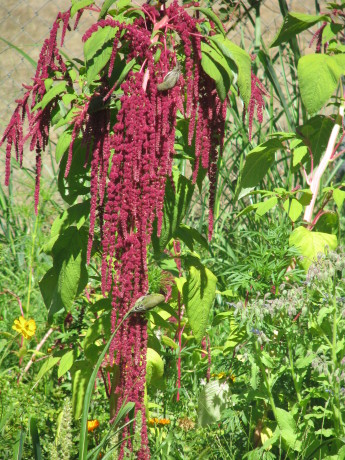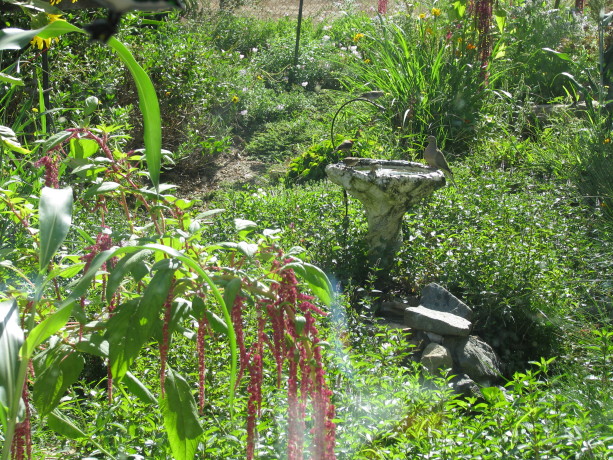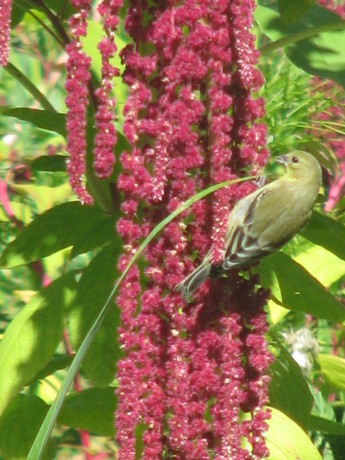Growing Birdseed: Love Lies Bleeding Amaranth

We’ve participated in Cornell University’s winter Project Feederwatch for about six years. It is a volunteer amateur scientist-type program where, from November through March, you fill bird feeders and two days a week count how many birds come. Then you report your results on an online form. This helps trace changes in migration patterns and in habitats in wild birds, as well as sitings of diseased birds.

This year I found out that most birdseed is contaminated by insecticide; some brands are reported to have illegal levels of pesticides in them. Geez! How am I going to get around that problem? I’m not sure about this winter, but I’m going to grow more of my own birdseed. In the past we’ve rolled pine cones in peanut butter and hung them out for woodpeckers and many other birds. I’ve also grown sunflowers, for both their seeds and for their leaves, which lesser goldfinches just love to eat! This year I planted heirloom Love Lies Bleeding Amaranth (Amaranthus caudatus) to some pretty spectacular results. Yes, this is one of the types of amaranth that produces an edible seed for humans; the leaves are edible as well. It can grow 3 -6 feet, with long ruby-red falls of seed heads that the birds just love.

There are many other amaranths to grow for both your own consumption as well as for the birds. Sometimes you grow it for yourself and end up feeding the birds! Of course there are many plants which attract hummingbirds all year, especially those with tubular flowers. Why do you want to attract birds? Besides their right to habitat, and their appeal to our better selves, all native animals play important roles in the preditor/prey relationship in a healthy garden. The birds may eat some of your produce, but they are also eating large amounts of bugs. They are also pooping, and you know how valuable poop is to any garden! If you plant a bird garden away from your vegetable crops, then plant your veg crops using the polyculture method, you will have birds and food for yourself as well. Please, please don’t put up those dangerous tree nets! They tear apart your trees when you try to remove them, they don’t really work, and birds can be stuck in them. When they are on the ground snakes are trapped in them! No plastic netting. Ever. Please!
Try planting some amaranth – especially this one with the dramatic name and dramatic fall of color – next spring when you plant a bird garden. Or in your edible forest garden and plant guilds. Or between your fruit trees, or along the back of your flower beds. Take a nibble for yourself if the birds will let you!

6 Comments
Diane
Hi Margaret, we found a very fine mesh that worked over the top of our plum tree. Agfabric Standard Insect Screen & Garden Netting Against Bugs, Birds & Squirrels – Mesh Netting, White (10’x10′), from Amazon. We bought a couple of lengths, which was a little pricey, but it is completely reusable. We put it on after fruit set, and used clothes pins to hold it together, although some of them needed replacement by the end. It didn’t snag on branches and pull off leaves, or hurt birds or other creatures, and even in our very hot summers the fabric didn’t degrade so it will last many years.
Others have used mylar strips and shiny whirligigs on trees to keep birds away, or hanging old CDs, so the flashing keeps away most birds, but I don’t know whether it works on squirrels as well. If you have access to any kind of predator urine, that would help keep the rodents and squirrels away. It is a battle sometimes to keep enough fruit for oneself when the animals are hungry, too. Thanks for reading and best of luck! Diane
Margaret M Cassidy
what do you recommend instead of a net to put over say, a cherry tree? I would like to keep the squirrels and birds away so I get some of the fruit for me.
Diane
Hi Chas, if you are positive that that is the plant in question, then definitely. It is a colored amaranth. Baker Creek seeds offer a variety of colored amaranths, too. Thanks for reading! Diane
chas
Can i eat the seed from the love lies bleeding plant?
Diane
Hi Tony,
thank you for commenting. Yes, I give permission to use the photo with credit on your site. I enjoy the Native Plants and Wildlife Garden site and Wren Song. I look forward to seeing the post. Thank you for what you’re doing! Diane
Tony McGuigan
Dear Vegetariat,
Nice article about amaranth. I have also been enjoying other postings on your site — great recipes!
May I use the above photo, captioned “One of our Finch Frolic Finches feeding!”? I will give credit to your site and link back to you. I am writing a post for Native Plants and Wildlife Gardens, http://nativeplantwildlifegarden.com/ .
Thank you.
Tony